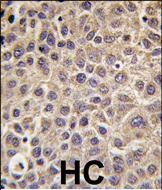MTMR9 Antibody
Purified Rabbit Polyclonal Antibody (Pab)
- 产品详情
- 实验流程
- 背景知识
Application
| WB, IHC-P, E |
|---|---|
| Primary Accession | Q96QG7 |
| Other Accession | Q96QG7, NP_060147 |
| Reactivity | Human, Mouse |
| Host | Rabbit |
| Clonality | Polyclonal |
| Isotype | Rabbit IgG |
| Calculated MW | 63462 Da |
| Antigen Region | 518-549 aa |
| Gene ID | 66036 |
|---|---|
| Other Names | Myotubularin-related protein 9, 313-, MTMR8 |
| Target/Specificity | This MTMR8 antibody is generated from rabbits immunized with a KLH conjugated synthetic peptide between 518-549 amino acids from the C-terminal region of human MTMR8. |
| Dilution | WB~~1:1000 IHC-P~~1:100~500 E~~Use at an assay dependent concentration. |
| Format | Purified polyclonal antibody supplied in PBS with 0.09% (W/V) sodium azide. This antibody is prepared by Saturated Ammonium Sulfate (SAS) precipitation followed by dialysis against PBS. |
| Storage | Maintain refrigerated at 2-8°C for up to 2 weeks. For long term storage store at -20°C in small aliquots to prevent freeze-thaw cycles. |
| Precautions | MTMR9 Antibody is for research use only and not for use in diagnostic or therapeutic procedures. |
| Name | MTMR9 |
|---|---|
| Synonyms | C8orf9, MTMR8 |
| Function | Acts as an adapter for myotubularin-related phosphatases (PubMed:19038970, PubMed:22647598). Increases lipid phosphatase MTMR6 catalytic activity, specifically towards phosphatidylinositol 3,5- bisphosphate and MTMR6 binding affinity for phosphorylated phosphatidylinositols (PubMed:19038970, PubMed:22647598). Positively regulates lipid phosphatase MTMR7 catalytic activity (By similarity). Increases MTMR8 catalytic activity towards phosphatidylinositol 3- phosphate (PubMed:22647598). The formation of the MTMR6-MTMR9 complex, stabilizes both MTMR6 and MTMR9 protein levels (PubMed:19038970). Stabilizes MTMR8 protein levels (PubMed:22647598). Plays a role in the late stages of macropinocytosis possibly by regulating MTMR6-mediated dephosphorylation of phosphatidylinositol 3-phosphate in membrane ruffles (PubMed:24591580). Negatively regulates autophagy, in part via its association with MTMR8 (PubMed:22647598). Negatively regulates DNA damage-induced apoptosis, in part via its association with MTMR6 (PubMed:19038970, PubMed:22647598). Does not bind mono-, di- and tri- phosphorylated phosphatidylinositols, phosphatidic acid and phosphatidylserine (PubMed:19038970). |
| Cellular Location | Cytoplasm. Cell projection, ruffle membrane {ECO:0000250|UniProtKB:Q9Z2D0}; Peripheral membrane protein; Cytoplasmic side. Cytoplasm, perinuclear region Endoplasmic reticulum. Note=Localizes to ruffles during EGF-induced macropinocytosis (By similarity) Colocalizes with MTMR6 to the perinuclear region (PubMed:19038970) Partially localizes to the endoplasmic reticulum (PubMed:19038970) {ECO:0000250|UniProtKB:Q9Z2D0, ECO:0000269|PubMed:19038970} |
| Tissue Location | Expressed in many tissues. |
For Research Use Only. Not For Use In Diagnostic Procedures.
Provided below are standard protocols that you may find useful for product applications.
BACKGROUND
MTMR8 is a myotubularin-related protein that is atypical to most other members of the myotubularin-related protein family because it has no dual-specificity phosphatase domain. The encoded protein contains a double-helical motif similar to the SET interaction domain, which is thought to have a role in the control of cell proliferation. In mouse, a protein similar to the encoded protein binds with MTMR7, and together they dephosphorylate phosphatidylinositol 3-phosphate and inositol 1,3-bisphosphate.
REFERENCES
Appel, S., et al., Eur. J. Hum. Genet. 10(1):17-25 (2002).
Appel, S., et al., Genomics 75 (1-3), 6-8 (2001).
终于等到您。ABCEPTA(百远生物)抗体产品。
点击下方“我要评价 ”按钮提交您的反馈信息,您的反馈和评价是我们最宝贵的财富之一,
我们将在1-3个工作日内处理您的反馈信息。
如有疑问,联系:0512-88856768 tech-china@abcepta.com.























 癌症的基本特征包括细胞增殖、血管生成、迁移、凋亡逃避机制和细胞永生等。找到癌症发生过程中这些通路的关键标记物和对应的抗体用于检测至关重要。
癌症的基本特征包括细胞增殖、血管生成、迁移、凋亡逃避机制和细胞永生等。找到癌症发生过程中这些通路的关键标记物和对应的抗体用于检测至关重要。 为您推荐一个泛素化位点预测神器——泛素化分析工具,可以为您的蛋白的泛素化位点作出预测和评分。
为您推荐一个泛素化位点预测神器——泛素化分析工具,可以为您的蛋白的泛素化位点作出预测和评分。 细胞自噬受体图形绘图工具为你的蛋白的细胞受体结合位点作出预测和评分,识别结合到自噬通路中的蛋白是非常重要的,便于让我们理解自噬在正常生理、病理过程中的作用,如发育、细胞分化、神经退化性疾病、压力条件下、感染和癌症。
细胞自噬受体图形绘图工具为你的蛋白的细胞受体结合位点作出预测和评分,识别结合到自噬通路中的蛋白是非常重要的,便于让我们理解自噬在正常生理、病理过程中的作用,如发育、细胞分化、神经退化性疾病、压力条件下、感染和癌症。







